Introduction
You may identify the need to import Pledge Accounts and their prior transactions to your CharityEngine instance. Leveraging the Workflow & Automation Importer tool will allow CharityEngine users with the ability to create pledge accounts in bulk while also connecting prior transactions to the pledge account to reflect accurate pledge balances.
Table of Contents
- Introduction
- Prerequisites
- Prerequisites - Best Practices for Data Preparation
- Preparing your import files
- Instructions: Creating a Custom Pledge Type
- Instructions: How to Import Pledge Accounts - Step 1
- Instructions: How to Import Historical Pledge Transactions - Step 2
- Instructions: How to Evaluate Bad Records
- FAQs & Other Recommended Readings
Prerequisites
- CRITICAL NOTE: Preparing your data is an important exercise to ensure your data is properly formatted and will be prepared for importing
- NOTE: In order to import Pledge records, the minimum required fields will include an existing CharityEngine Contact ID, an existing pledge type, and a total pledge amount.
- If your data does not contain a CharityEngine Contact ID, you will need to create the contact record.
- If your data does not contain an existing CharityEngine Pledge Type, please follow the steps below to create your Pledge Type(s) for your organization.
Prerequisites - Best Practices for Data Preparation
When preparing your data, data cleansing practices are incredibly important to ensure you are importing good, clean data for your database. Here are a few examples to assist with data cleansing prior to import.
-
- -Does each row contain a unique pledge account.
- Please review for rows containing null values within your data import as these may result in importing errors
- -Is the mailing address properly formatted - if the contact contains Address Line 1, Address Line 2, City, State, Postal Code, and/or Country, all address fields will be required
- CharityEngine recommends use of a full mailing record for best data practices. If the full address does not exist, best data practice is to leave full address as null.
- If the record contains partial address data elements and still require import, below are recommended placeholders. Please note, the use of these placeholders will create duplication and impact downstream reporting and functionality usage
- UNITED STATES
- Street 1: 123 Missing Street
- Street 2:
- Postal Code: 00000
- City: MISSING
- State: AA
- ALL OTHER COUNTRIES
- Street 1: MISSING
- Street 2:
- Postal Code: 000000
- City: MISSING
- State: AA
- UNITED STATES
- -Does each row contain a unique pledge account.
-
- -Is the email address properly formatted and include the presence of "@" and a ".com/org/net" etc.
- -Are phone numbers properly formatted (most formats are acceptable including 201.555.1234, 2015551234,(201)555.1234, 201-555-1234)
-
- Conditional Formatting in Excel:
- -Select the cells you want to check for duplicates
- -In Excel click Home > Conditional Formatting > Highlight Cell Rules > Duplicate Values
- -In the box next to values with, pick the formatting you want to apply to the duplicate values, and then click OK
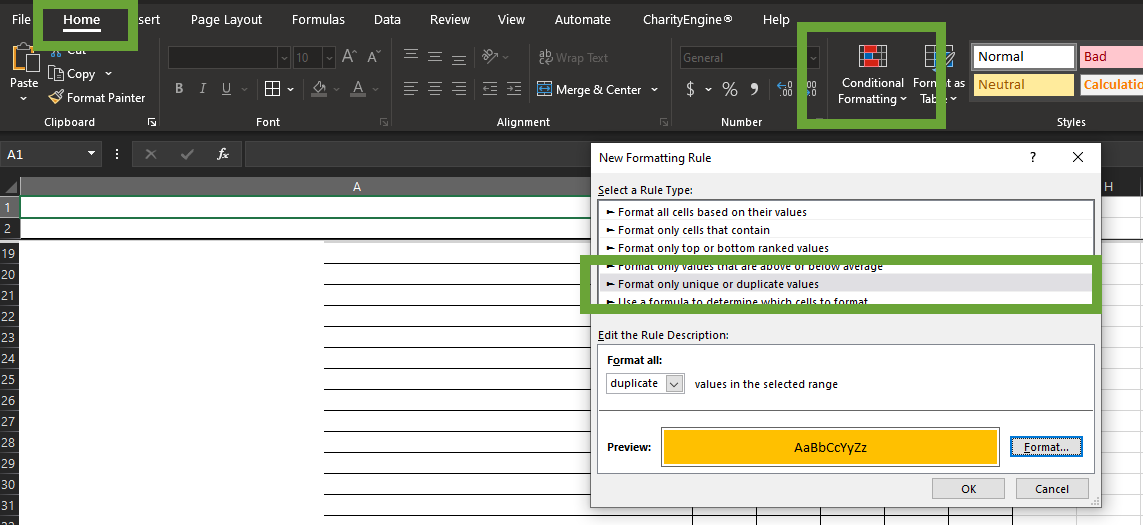
- Removing Duplicates in Excel:
- In Excel click Data > Remove Duplicates
- In the popup box, select your columns for matching values
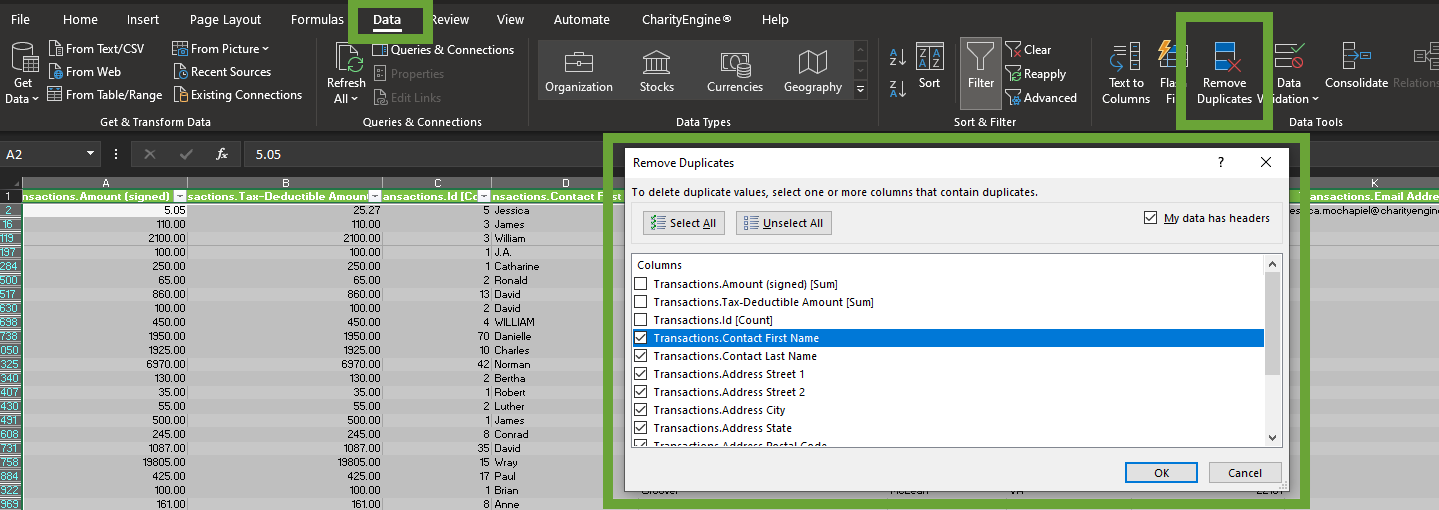
- Conditional Formatting in Excel:
-
- Sort & Filter in Excel: Leverage the Excel Sort and Filter options under the Data Ribbon

- Sort & Filter in Excel: Leverage the Excel Sort and Filter options under the Data Ribbon
-
- Text to Columns Excel features to modify data including splitting fields (i.e. splitting a first name and last name)

- Text to Columns Excel features to modify data including splitting fields (i.e. splitting a first name and last name)
-
- Minimum import requirements when creating a pledge account will include the need of an existing CharityEngine Contact ID as well as a Pledge Type.
Preparing your import files
Step 1: Creating a Pledge Account
When importing pledges, preparation is an important activity to ensure you have clean data for your CharityEngine database. When importing Pledge Accounts, the minimum requirement is Contact ID, Pledge Amount (total) and Pledge Type.
The following table will provide you with basic data elements for importing. Provided below are details for the translated CharityEngine Field name. Please also notate importing requirements as outlined within Description.
| Table Import | Field Section | CharityEngine Field | Required | Description |
| Pledge | Contact Info | Contact ID | Yes | Existing CharityEngine ID |
| Pledge | Pledge | Type | Yes | See Configuration App > Pledges > Type to add unique pledge types to import |
| Pledge | Pledge | Amount | Yes | This is the total overall pledged amount. |
| Pledge | Pledge | Create Date | Original pledge account creation date | |
| Pledge | Payment Info | Payment Method | Primary payment method for pledge payments | |
| Pledge | Address | Customer Street Address Line 1 | Address to be associated with the pledge account | |
| Pledge | Address | Customer Address City | If Address Line 1, requires City, State, Postal Code | |
| Pledge | Address | Customer Address State | If Address Line 1, requires City, State, Postal Code; Format - 2 Alpha Value | |
| Pledge | Address | Customer Address Postal Code | If Address Line 1, requires City, State, Postal Code; Zip + 4 required for support of applications such as Advocacy and identification of County; please ensure leading 0 is present where appropriate (i.e. 01104) | |
| Pledge | Address | Customer Address Country | Assume US if null | |
| Pledge | Customer Email Address | Format: requires presence of @ and ".xxx" | ||
| Pledge | Phone | Customer Phone Number | Format expects 10-digit input; can be 210-555-1234, (210)555-1234, 2105551234 |
Click Here to Download a Pledge Account Import Template:
Step 2: Importing Previous (Historical) Pledge Payments
When importing pledges, preparation is an important activity to ensure you have clean data for your CharityEngine database. When importing Previous Pledge Payments, the minimum requirement is Contact ID, Pledge ID and Pledge Payment Amount.
The following table will provide you with basic data elements for importing. Provided below are details for the translated CharityEngine Field name. Please also notate importing requirements as outlined within Description.
| Table Import | Field Section | CharityEngine Field | Required | Description |
| Transaction | Donor Info | Contact ID | Yes | Existing CharityEngine Contact ID |
| Transaction | Attribution | Pledge ID | Yes | Existing CharityEngine Pledge Account ID |
| Transaction | Transaction | Amount | Yes | This is the individual pledge transaction amount. |
| Transaction | Transaction | Date | Date of original pledge payment transaction. | |
| Transaction | Transaction | Tax-Deductible Amount | This the individual pledge transaction tax-deductible amount. | |
| Transaction | Transaction | Payment Method | Payment method |
Click Here to Download a Historical Pledge Payments Import Template:
If the donor's pledge transactions are already located within CharityEngine and a transaction ID has been assigned, simply locate the CharityEngine Transaction ID and the Pledge Account ID.
| Table Import | Field Section | CharityEngine Field | Required | Description |
| Transaction | Transaction | Transaction ID | Yes | Existing CharityEngine Transactions ID |
| Transaction | Attribution | Pledge ID | Yes | Existing CharityEngine Pledge Account ID |
Click Here to Download a Historical Pledge Payments (With Existing CharityEngine Transaction ID) Import Template:
Step 3: Creating a Pledge Payment Schedule (if automated)
When importing pledges, preparation is an important activity to ensure you have clean data for your CharityEngine database. Once the Pledge Account, has been created and the pledge payment schedule is to be automated, the user will need to create a Pledge Installment Schedule. The minimum requirement is Pledge ID, Installment Frequency Start Date, Installment Frequency.
The following table will provide you with basic data elements for importing. Provided below are details for the translated CharityEngine Field name. Please also notate importing requirements as outlined within Description.
| Table Import | Field Section | CharityEngine Field | Required | Description |
| Pledge | Pledge | Pledge ID | Yes | Existing CharityEngine Pledge ID |
| Pledge | Payment Info | Installment Amount | Yes | This is the recurring installment payment amount expected |
| Pledge | Payment Info | Installment Frequency | Yes | This is the recurring installment payment frequency (daily, weekly, bi-monthly, monthly, quarterly, bi-yearly, annually) |
| Pledge | Payment Info | Installment Start Date | Yes | Date of first or next installment payment. If the installment is active, it is important to use the next installment date or the database will assign the next installment as today. |
| Pledge | Payment Info | Installment End Date | Date of last installment payment |
Click Here to Download a Pledge Installment Schedule Import Template:
Instructions: Creating a Custom Pledge Type
If the user is creating a pledge account, please follow these steps to configure a unique pledge type for the non-profit organization. This step is critical needed in order to import and create pledge accounts.
Step 1: Navigate to the Configuration App > Pledges > Types > Create New
Step 2: Create a Name (required) - this is an external reference if used with Web Forms. Create Code (required) - this is an internal reference.
Step 3: Click SAVE to secure your changes.

Step 4: Navigate back to the listing screen to locate the new Pledge Types. This value will be used in the Pledge Account create import.
Instructions: How to Import Pledge Accounts - Step 1
Now that you have cleansed your data, added your pledge type, identified all pledge totals, and added your CharityEngine Contact IDs to the import template, you are ready to begin importing. CharityEngine recommends importing a small sample to begin. This allows the user to QA and verify the data has imported as expected.
The user can choose to leverage the Import (new) or Import (classic). Classic workflow guides end user to map fields manually and then import the source file. Alternatively, new import flow guides end user to upload source file and then user will be guided to map based upon the column headers.
Importing with Import (new)

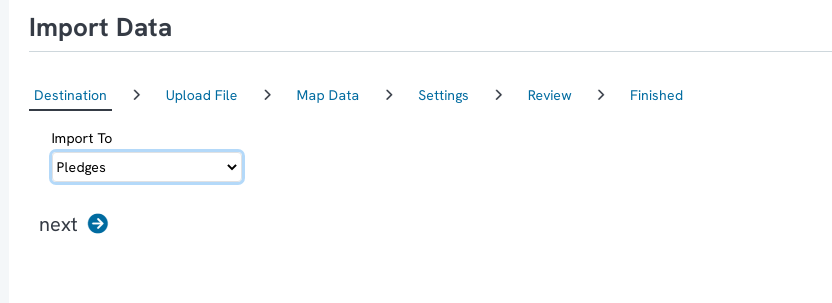
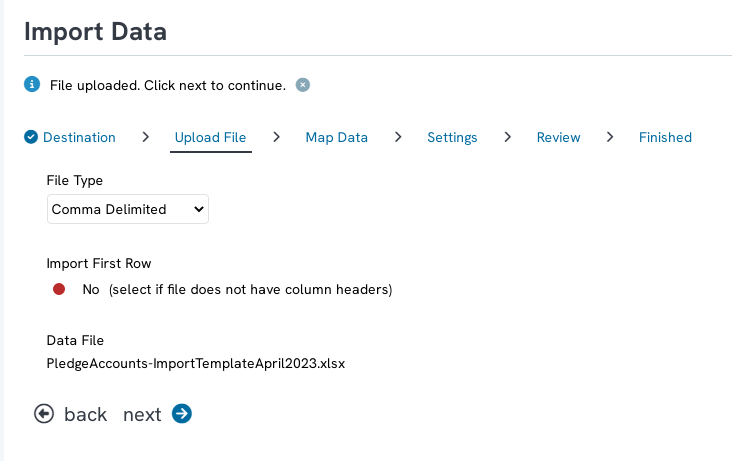
-
-
- Leverage Existing Template to locate any prior templates for faster mapping
- MAP FILE COLUMNS:
- Use the drop down from each column to select the appropriate field selection for mapping
- Select IGNORE if you wish to have the importer skip importing/updating the contact record
- To save the template for future use, ensure Save Template is toggled to Yes. This will allow you to save time by loading the template instead of adding the fields one by one. This will also be helpful if you plan to import a sample and then complete a full import. Or if using an existing template, adjust Save Changes to adjust for any modifications of column mapping changes that may be needed for future reference.
-
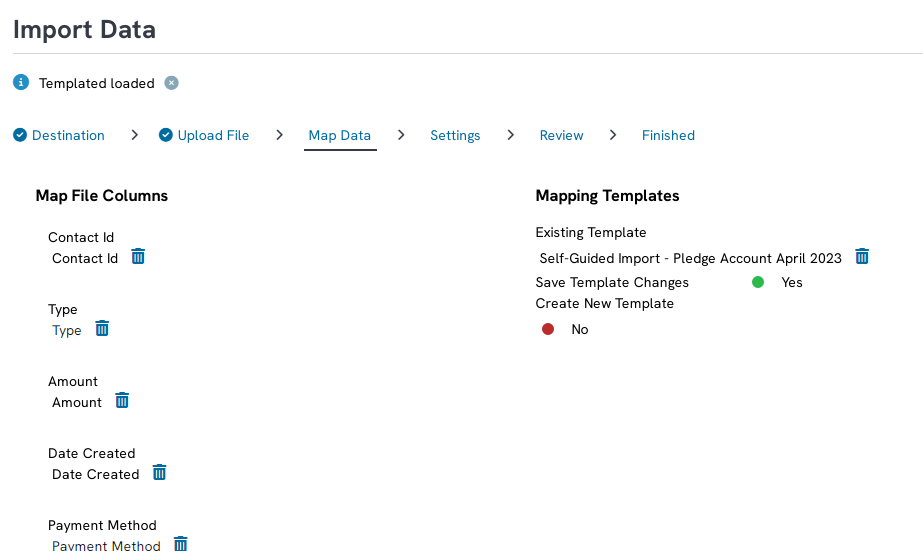
Step 6: Next, prepare your settings for import. Modify the Name of the import job (optional), Mode: Import Data (preset), Start if you wish to schedule in the future (optional). Click next to proceed.
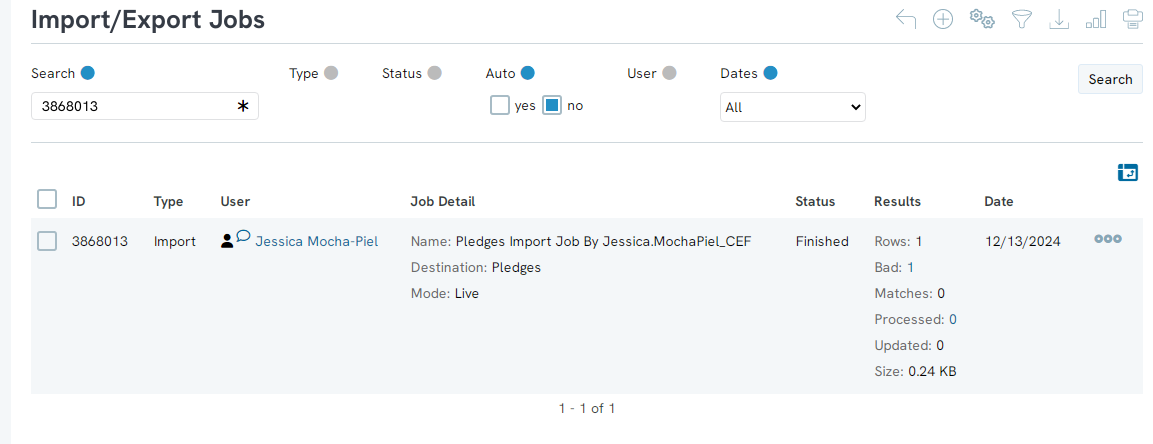
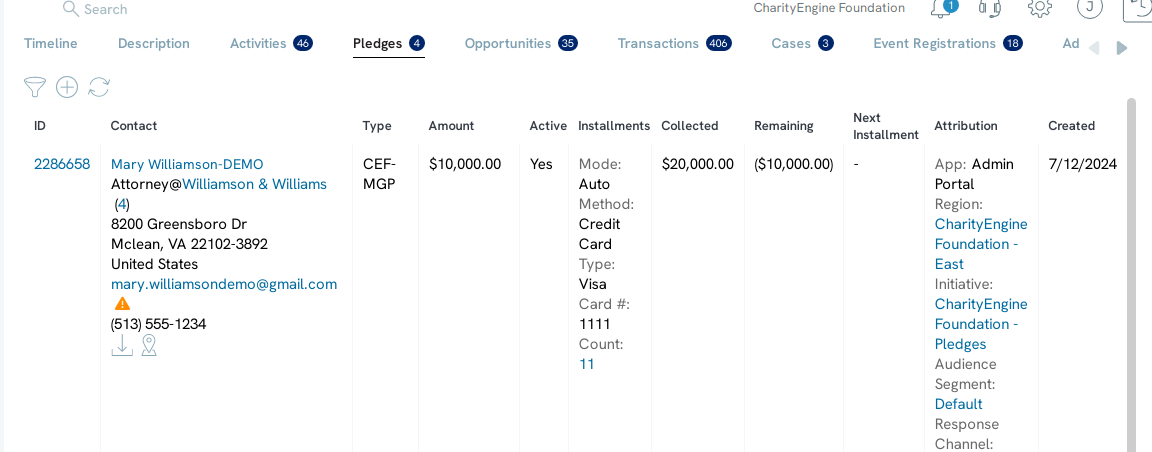
Instructions: How to Import Historical Pledge Transactions - Step 2
Now that you have created your pledge accounts (and created installment schedules where/if applicable), the next step is to connect previous pledge transactions (historical) with the new pledge account. This allows accurate reporting of remaining pledge balances. CharityEngine recommends importing a small sample to begin. This allows the user to QA and verify the data has imported as expected.
The user can choose to leverage the Import (new) or Import (classic). Classic workflow guides end user to map fields manually and then import the source file. Alternatively, new import flow guides end user to upload source file and then user will be guided to map based upon the column headers.
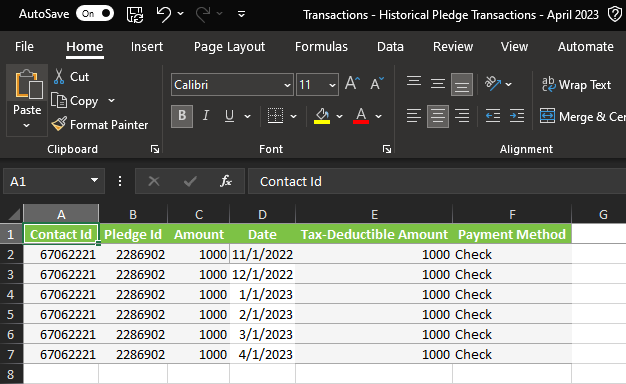

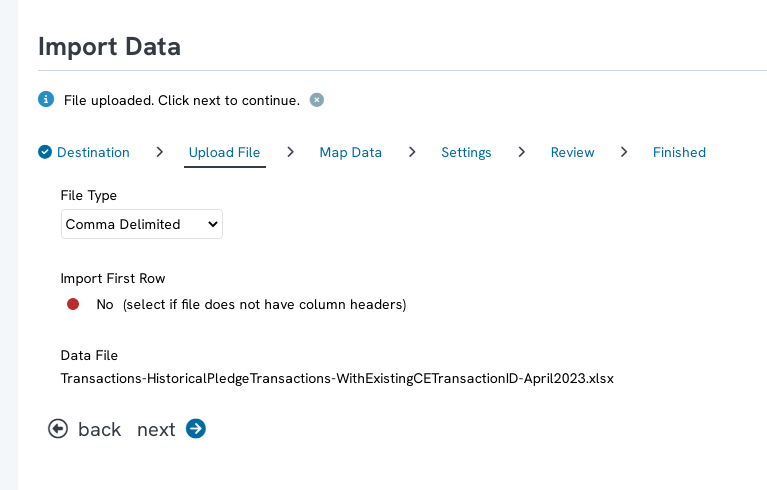
-
-
- Leverage Existing Template to locate any prior templates for faster mapping
- MAP FILE COLUMNS:
- Use the drop down from each column to select the appropriate field selection for mapping
- Select IGNORE if you wish to have the importer skip importing/updating the contact record
- To save the template for future use, ensure Save Template is toggled to Yes. This will allow you to save time by loading the template instead of adding the fields one by one. This will also be helpful if you plan to import a sample and then complete a full import. Or if using an existing template, adjust Save Changes to adjust for any modifications of column mapping changes that may be needed for future reference.
-
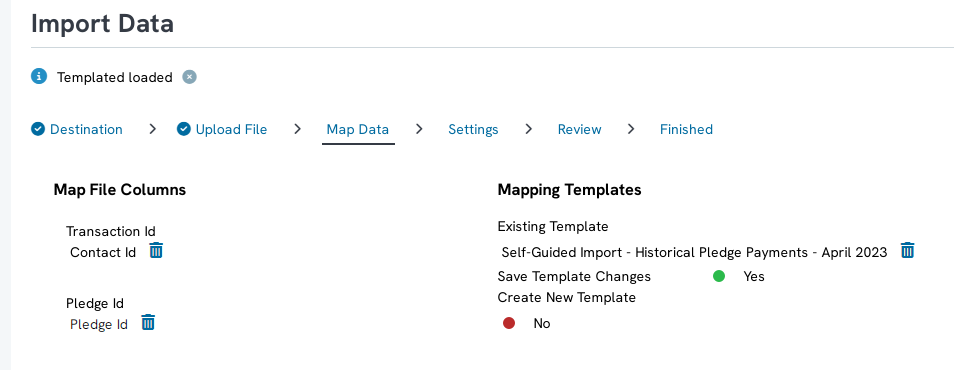
Step 6: Next, prepare your settings for import. Modify the Name of the import job (optional), Mode: Import Data (preset), Start if you wish to schedule in the future (optional). Click next to proceed.
Instructions: How to Evaluate Bad Records
If you import
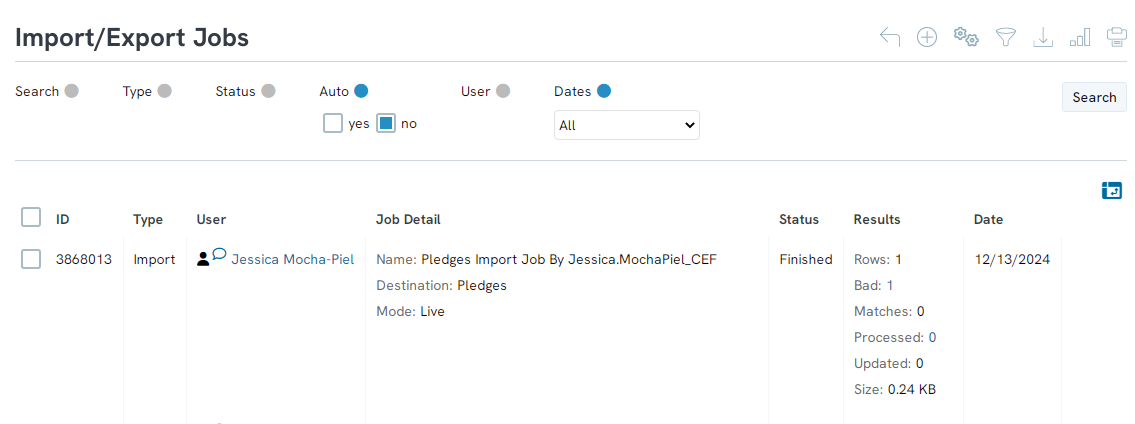
By clicking the number next to Bad, you will be able to see the file error. This will appear in a NotePad pop-up advising you what error was made. once you have found the error, you will be able to fix your file and try to import again.
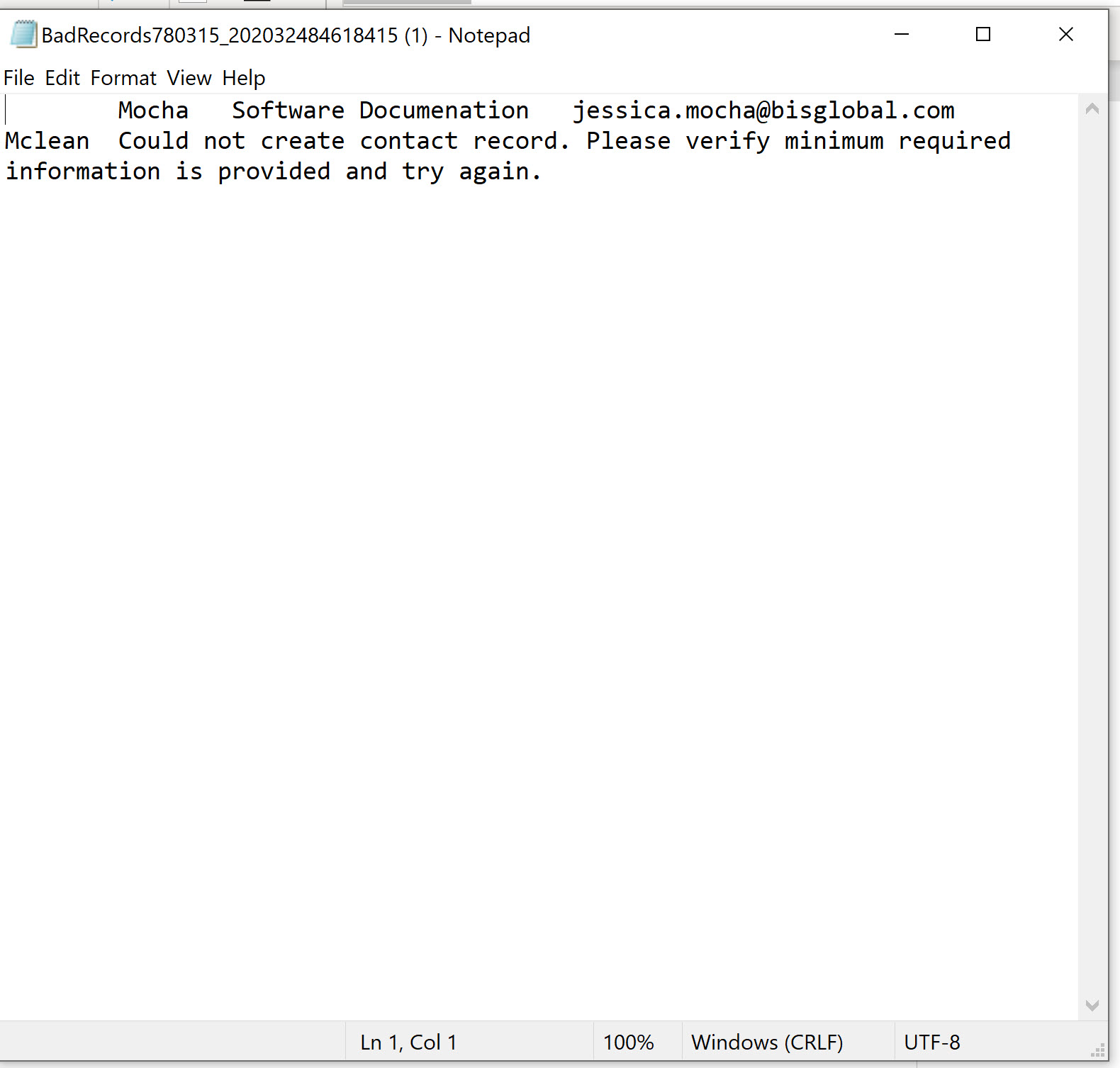
FAQs & Other Recommended Readings
Q. I'd like to learn more about the overall structure and management of Pledge Accounts in CharityEngine.
A. See our article Pledge: How to Create and Manage Pledges
Q. I need to import Contact - Organizations. What resources are available for support?
A. Please see our article Data Importing: How to Import Contact - Organization Data
Q. I need to import Contact - Household. What resources are available for support?
A. Please see our article Data Importing: How to Import Contact - Household Data
Q. I need to import Contact - Transactions. What resources are available for support?
A. Please see our article Data Importing: How to Import Transactions
